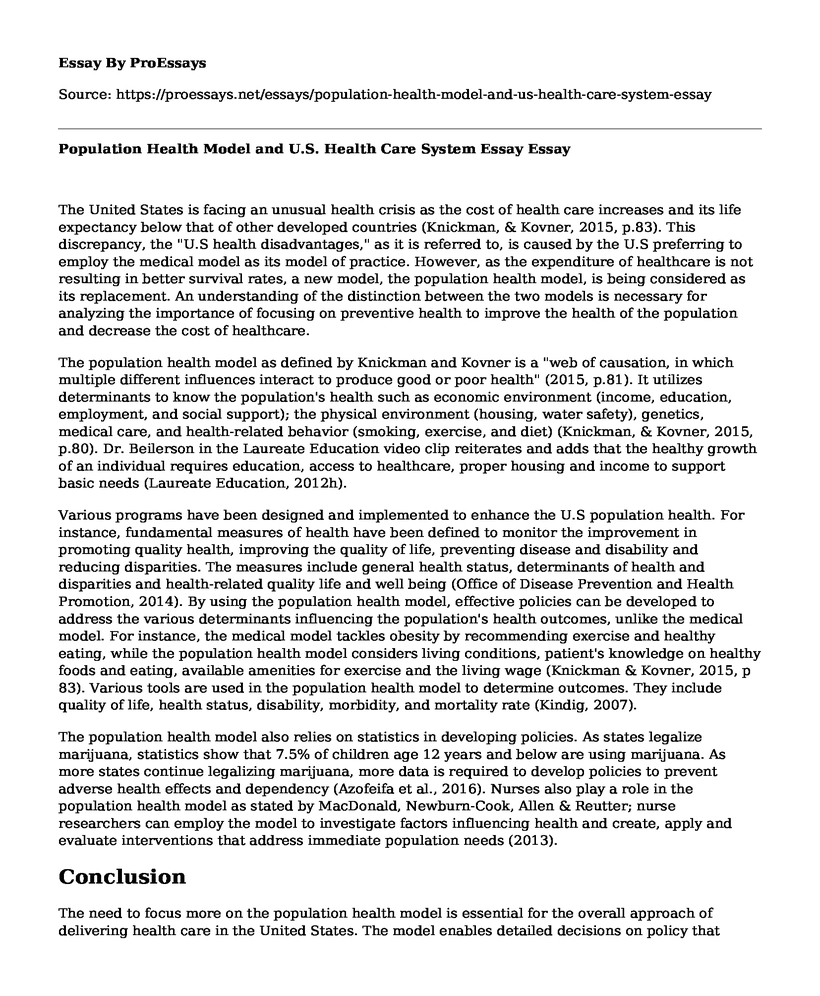The United States is facing an unusual health crisis as the cost of health care increases and its life expectancy below that of other developed countries (Knickman, & Kovner, 2015, p.83). This discrepancy, the "U.S health disadvantages," as it is referred to, is caused by the U.S preferring to employ the medical model as its model of practice. However, as the expenditure of healthcare is not resulting in better survival rates, a new model, the population health model, is being considered as its replacement. An understanding of the distinction between the two models is necessary for analyzing the importance of focusing on preventive health to improve the health of the population and decrease the cost of healthcare.
The population health model as defined by Knickman and Kovner is a "web of causation, in which multiple different influences interact to produce good or poor health" (2015, p.81). It utilizes determinants to know the population's health such as economic environment (income, education, employment, and social support); the physical environment (housing, water safety), genetics, medical care, and health-related behavior (smoking, exercise, and diet) (Knickman, & Kovner, 2015, p.80). Dr. Beilerson in the Laureate Education video clip reiterates and adds that the healthy growth of an individual requires education, access to healthcare, proper housing and income to support basic needs (Laureate Education, 2012h).
Various programs have been designed and implemented to enhance the U.S population health. For instance, fundamental measures of health have been defined to monitor the improvement in promoting quality health, improving the quality of life, preventing disease and disability and reducing disparities. The measures include general health status, determinants of health and disparities and health-related quality life and well being (Office of Disease Prevention and Health Promotion, 2014). By using the population health model, effective policies can be developed to address the various determinants influencing the population's health outcomes, unlike the medical model. For instance, the medical model tackles obesity by recommending exercise and healthy eating, while the population health model considers living conditions, patient's knowledge on healthy foods and eating, available amenities for exercise and the living wage (Knickman & Kovner, 2015, p 83). Various tools are used in the population health model to determine outcomes. They include quality of life, health status, disability, morbidity, and mortality rate (Kindig, 2007).
The population health model also relies on statistics in developing policies. As states legalize marijuana, statistics show that 7.5% of children age 12 years and below are using marijuana. As more states continue legalizing marijuana, more data is required to develop policies to prevent adverse health effects and dependency (Azofeifa et al., 2016). Nurses also play a role in the population health model as stated by MacDonald, Newburn-Cook, Allen & Reutter; nurse researchers can employ the model to investigate factors influencing health and create, apply and evaluate interventions that address immediate population needs (2013).
Conclusion
The need to focus more on the population health model is essential for the overall approach of delivering health care in the United States. The model enables detailed decisions on policy that eventually decrease the cost of healthcare while preventing more diseases.
References
Azofeifa, A., Matson, M. E., Shauer, G., et al. (2016). National Estimates of Marijuana Use and Related Indicator- National Survey on Drug Use and Health, United States, 2002-2014. MMWR Surveillance Summary 2016; 65 (No. SS-11):1-25. Retrieved from http://www.cdc.gov/mmwr/volumes/65/ss/ss6511a1.htm
Kindig, D. (2007). Understanding Population Health Terminology. The Milbank Quarterly 85 (1), 139-161. Retrieved from the Walden Library databases.
Knickman, J. R., & Kovner, A. R. (2015). Health Care Delivery in the United States (11th ed.). New York, NY: Springer Publishing Company, LLC.
Laureate Education (Producer). (2012h). Population Health. Baltimore, MD: Author
MacDonald, S.E., Newburn-Cook, C. V., Allen, M. & Reutter, L. (2013). Embracing the Population Health in Nursing Research. Nursing Inquiry 20 (1): 30-41. DOI: 10.1111/nin.2017
Office of Diseases Prevention and Health Promotion (2014). Foundation Health Measures. Retrieved from https://www.healthypeople.gov/2020/about/Foundation-Health-Measures.
Cite this page
Population Health Model and U.S. Health Care System Essay. (2022, Oct 20). Retrieved from https://proessays.net/essays/population-health-model-and-us-health-care-system-essay
If you are the original author of this essay and no longer wish to have it published on the ProEssays website, please click below to request its removal:
- Essay on Workplace Safety Tips for Natural Disasters
- Risk Reduction Strategies Aimed at Preventing Wrong Site Surgery
- Essay Sample on Universal Health Care System
- Essay Sample on Parenteral and Enteral Nutrition in Special Populations
- Paper Example on ANA Code of Ethics: A Guide to Professional Practice in Healthcare
- Essay Example on China's College Entrance Exam: Merits & Reforms
- Psychiatric Diagnosis Outline Paper Example







